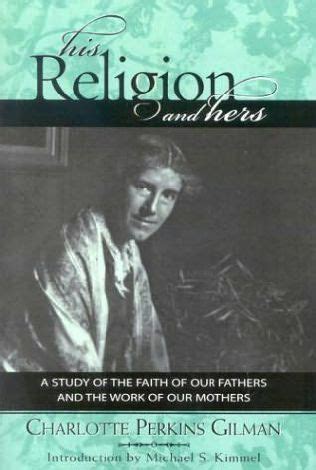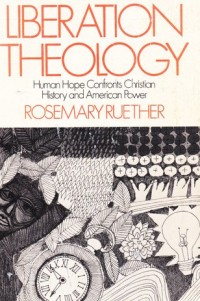Editor's Note
This guest post is another from intellectual and gender historian Lilian Calles Barger. Barger further explores the themes in this essay in her book The World Come of Age: An Intellectual History of Liberation Theology, Oxford University Press, 2018. She is currently researching the history of feminist thought and the gender revolution. @lilianbarger
— Anthony Chaney
“What would have been the effect upon religion if it had come to us through the minds of women?” That’s a question that Charlotte Perkins Gilman asked in her little-known book, His Religion and Hers: A Study of the Faith of Our Fathers and the Work of Our Mothers (1923), and a question that modern feminism continues to ask. Elizabeth Cady Stanton concluded, after having endured decades of resistance against women’s political rights, that religion inspired by men’s drive for domination had been the chief opponent of women. This was a view she had long held and expressed in an 1852 letter to the Women’s Rights Convention, writing, “In her present ignorance, woman’s religion, instead of making her noble and free, by the wrong application of great principles of right and justice, has made her bondage but more certain and lasting, her degradation more hopeless and complete.” This scathing complaint against Christianity that reigned over America persisted through the twentieth century. As  women like Stanton considered abandoning their inherited faith, Gilman, seeing the positive values offered by religion along with its negative social and political effects, attempted to move toward reconciliation. Both Gilman and Stanton offered the foundational reasoning for feminist theology.[1]
women like Stanton considered abandoning their inherited faith, Gilman, seeing the positive values offered by religion along with its negative social and political effects, attempted to move toward reconciliation. Both Gilman and Stanton offered the foundational reasoning for feminist theology.[1]
In her utopian novel, Herland (1915), Gilman described the religion of a woman’s utopia through the eyes of the male narrator and intrepid scientist Vandyck Jennings. Traveling through a mysterious land of an advanced civilization, Jennings falls in love with the heroine Ellador. She teaches him the elemental features of the “Divine Force.” Instead of a religion of “Dominant Power,” a “Vengeance-is-mine God,” and taboos, the religion of Herland involves a “Mother Spirit” and an “Indwelling Spirit.” Jennings finds this religion to be the most Christian of all, embracing rationality and rejecting what Gilman called a “death-based religion” in order to embrace a “birth-based” one. The religion of Jennings’s world demonstrated an unhealthy otherworldly concern emerging from what Gilman described in His Religion and Hers as “the soaring, imaginative minds of men, constructing lofty, shimmering piles of abstract thought.” These men, “taking as their postulate a revelation from God, gave us religions which could not possibly be maintained without belief and obedience … we find them most permanent and changeless among people who make the least effort to square their beliefs with the laws of life.” The “laws of life,” discovered by Gilman and evolutionary science, were denied by many fervent believers.[2]
Gilman, considering herself both a preacher and a sociologist, sought a solution to the conflict between facts found by science and the values offered by religion for organizing society—a project that drew the attention of social scientists and theologians from 1880 to 1930. The period gave birth to the social gospel and efforts to bring religion and evolutionary science together. Seeking the foundations for a new egalitarian society envisioned in Women and Economics: A Study of the Economic Relation Between Men and Women as a Factor in Social Evolution (1898), Gilman viewed religion as a “lever to move the world,” giving men the motivation for action, and viewed the religion of Jesus as offering the greatest opportunity for race improvement. How much more useful, she asked, if it was grounded on a secure foundation of fact? Searching across the world’s great religions, she looked for a unified, perennial tradition based in reason and nature. Drawing on Lester Ward’s Gynocentric theory of female superiority, she believed that “a normal feminine influence in recasting our religious assumptions will do more than any other one thing to improve the world.” Gilman’s religion based on feminine values can be seen as a precursor to the feminist theology of the 1970s.[3]
The relationship between feminism, particularly of the radical kind, and religion assumes estrangement and an unresolvable conflict. The Catholic feminist theologian and philosopher Mary Daly became the stand-in for that relationship of animosity. Her book, Beyond God the Father: Toward a Philosophy of Women’s Liberation (1973), claimed women’s right to name self, God, and the world, and “castrated” the language of a “He-God” built on a “phallocentric” ethic. This was Daly’s exodus from all monotheistic religion to a divine elemental Self. Like Gilman, Daly sought to replace a hierarchal God above with a woman-centered ethic of a God within. As readers may already sense, feminist theology that sought to recover values associated with women was navigating the dangerous waters of gender essentialism.[4]
Rather than assuming a repudiation of religion by modern feminism, I have sought a critical engagement with that tangled history. My recent essay, “‘Pray to God, She Will Hear Us’: Women Reimagining Religion and Politics in the 1970s,” demonstrates how it was not just the liberal wing of feminism but also the radical women’s liberation movement that carried a deeply religious impulse. Religious women brought religion into consciousness-raising groups and changed both religion and feminism in ways still evident today. (Consider the spillover of the #MeToo movement into #ChurchToo.) I continue with this line of thought in my book The World Come of Age: An Intellectual History of Liberation Theology (2018), demonstrating how feminist religious radicals reimagined a liberatory social ethic that began with a reconceptualization of the Divine.[5]
 In the 1970s, another Catholic feminist theologian, Rosemary Radford Ruether, set out to deconstruct the language, symbols, and ecclesial hierarchy supporting women’s subordination. Whereas Daly ultimately rejected Christianity, Ruether, joined by the first generation of Protestant liberation theologians, remained in order to redefine it from within. Overturning a sexist theology that had been defined by men became the raison d’être of feminist theology. Ruether, similarly to Gilman, advocated the Great Mother, “the Matrix and ground of our being,” and saw social science as a theological partner for constructing a politically effective religious ethic. Calling for the transformation of values for human liberation, Ruether argued for expanding the parameters of theology: “Only with such a multi-disciplinary integration of human sciences can we begin to speak of the basis for a theology of liberation.” The partnership of social science and theology expanded the “horizon of human liberation in its fully redemptive context” and recognized the whole person in his or her social, political, ecological, economic, and spiritual contexts rather than with mere concern for a private religious self. By the end of the twentieth century, social theory, feminism, and theology had reached multiple points of convergence, yielding a new feminist religious consciousness. Gilman’s question and Stanton’s complaint were answered through the emergence of a fully recognizable feminist theology.[6]
In the 1970s, another Catholic feminist theologian, Rosemary Radford Ruether, set out to deconstruct the language, symbols, and ecclesial hierarchy supporting women’s subordination. Whereas Daly ultimately rejected Christianity, Ruether, joined by the first generation of Protestant liberation theologians, remained in order to redefine it from within. Overturning a sexist theology that had been defined by men became the raison d’être of feminist theology. Ruether, similarly to Gilman, advocated the Great Mother, “the Matrix and ground of our being,” and saw social science as a theological partner for constructing a politically effective religious ethic. Calling for the transformation of values for human liberation, Ruether argued for expanding the parameters of theology: “Only with such a multi-disciplinary integration of human sciences can we begin to speak of the basis for a theology of liberation.” The partnership of social science and theology expanded the “horizon of human liberation in its fully redemptive context” and recognized the whole person in his or her social, political, ecological, economic, and spiritual contexts rather than with mere concern for a private religious self. By the end of the twentieth century, social theory, feminism, and theology had reached multiple points of convergence, yielding a new feminist religious consciousness. Gilman’s question and Stanton’s complaint were answered through the emergence of a fully recognizable feminist theology.[6]
_________
[1] Charlotte Perkins Gilman, His Religion and Hers: A Study of the Faith of Our Fathers and the Work of Our Mothers (Westport, CN: Hyperion Press, 1963), 45; Elizabeth Cady Stanton, the letter sent to the women’s rights convention in Syracuse, September 8, 1852, National American Woman Suffrage Association Collection, Library of Congress.
[2] Charlotte Perkins Gilman, Herland, “Chapter 10, Their Religion and Our Marriages,” Project Gutenberg, 2008. http://www.gutenberg.org/ebooks/32; Gilman, His Religion and Hers, 46, 229.
[3] His Religion and Hers, 5; See Malina Mamigonian, “ ‘Knowing good and evil’: Charlotte Perkins Gilman’s religion of ‘sound sociology.’ ” Interdisciplinary Literary Studies, 4:2 (Spring 2003): 56-83.
[4] Mary Daly, Beyond God the Father: Toward a Philosophy of Women’s Liberation, (Boston: Beacon Press, 1973), 18-19.
[5] Lilian Calles Barger, “ ‘Pray to God, She Will Hear Us’: Women Reimagining Religion and Politics in the 1970s,” in The Religious Left in Modern America: Doorkeepers of a Radical Faith edited by Douglas Rossinow, Leilah Danielson, and Marian Mollin (Palgrave Macmillan, 2018), 211-231.
[6] Rosemary Radford Ruether, Sexism and God-Talk: Toward a Feminist Theology (Boston: Beacon Press, 1983), 70; Ruether, Liberation Theology: Human Hope Confronts Christian History and American Power (New York: Paulist Press, 1972), 2.

One Thought on this Post
S-USIH Comment Policy
We ask that those who participate in the discussions generated in the Comments section do so with the same decorum as they would in any other academic setting or context. Since the USIH bloggers write under our real names, we would prefer that our commenters also identify themselves by their real name. As our primary goal is to stimulate and engage in fruitful and productive discussion, ad hominem attacks (personal or professional), unnecessary insults, and/or mean-spiritedness have no place in the USIH Blog’s Comments section. Therefore, we reserve the right to remove any comments that contain any of the above and/or are not intended to further the discussion of the topic of the post. We welcome suggestions for corrections to any of our posts. As the official blog of the Society of US Intellectual History, we hope to foster a diverse community of scholars and readers who engage with one another in discussions of US intellectual history, broadly understood.
In a certain sense, religion’s beginnings likely DID come to us through the eyes of women given the alleged prevalence of matriarchial prehistoric societies, and the continued change over time in the paradigm of religion gradually morphed away from its initial perspective into what we have today. However, as with most hypotheticals that not only couldn’t have existed because of the irreversibility of time (i.e., positing a hypothetical on an event that happened is pointless) but could not even exist in a recreated setting, it is rather pointless to consider the question. Certainly, it “would” have been different, but maybe “God” “would” have turned everyone into carrots. O.o
Who knows?